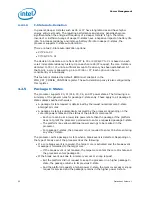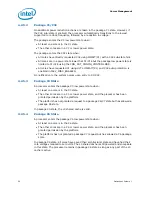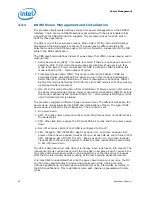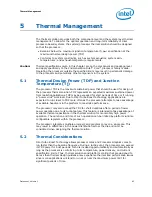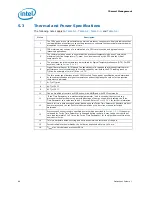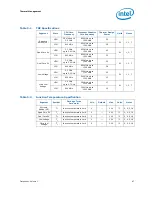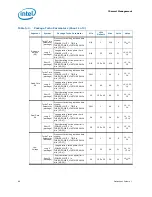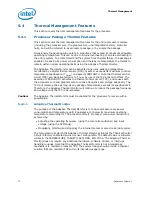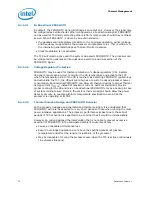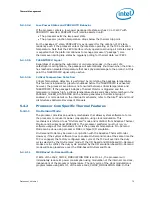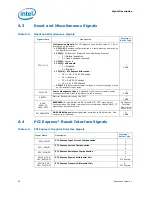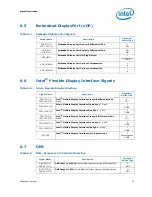
Thermal Management
66
Datasheet, Volume 1
5.3
Thermal and Power Specifications
The following notes apply to
,
.
Notes
Description
1
The TDPs given are not the maximum power the processor can generate. Analysis indicates that
real applications are unlikely to cause the processor to consume the theoretical maximum power
dissipation for sustained periods of time.
2
TDP workload may consist of a combination of a CPU-core intensive and a graphics-core
intensive applications.
3
The thermal solution needs to ensure that the processor temperature does not exceed the
maximum junction temperature (Tj,max) limit, as measured by the DTS and the critical
temperature bit.
4
The processor junction temperature is monitored by Digital Temperature Sensors (DTS). For DTS
accuracy, refer to
.
5
Digital Thermal Sensor (DTS) based fan speed control is required to achieve optimal thermal
performance. Intel recommends full cooling capability well before the DTS reading reaches
Tj,Max. An example of this is Tj,Max – 10 ºC.
6
The idle power specifications are not 100% tested. These power specifications are determined
by the characterization at higher temperatures and extrapolating the values for the junction
temperature indicated.
7
At Tj of Tj,max
8
At Tj of 50 ºC
9
At Tj of 35 ºC
10
Can be modified at runtime by MSR writes, with MMIO and with PECI commands
11
'Turbo Time Parameter' is a mathematical parameter (unit in seconds) that controls the
processor turbo algorithm using a moving average of energy usage. Avoid setting the Turbo
Time Parameter to a value less than 0.1 seconds. Refer to
for further information.
12
Shown limit is a time averaged power, based upon the Turbo Time Parameter. Absolute product
power may exceed the set limits for short durations or under virus or uncharacterized
workloads.
13
Processor will be controlled to specified power limit as described in
. If the power
value and/or ‘Turbo Time Parameter’ is changed during runtime, it may take a short period of
time (approximately 3 to 5 times the ‘Turbo Time Parameter’) for the algorithm to settle at the
new control limits.
14
This is a hardware default setting and not a behavioral characteristic of the part.
15
For controllable turbo workloads, the limit may be exceeded for up to 10 ms.
16
Tj
MAX
may vary between processor SKUs.

